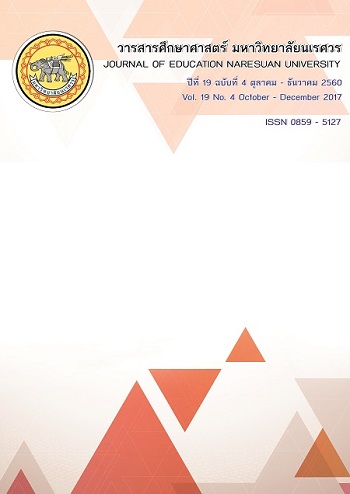INFLUENTIAL DETERMINANTS OF EDUCATIONAL TECHNOLOGY ACCEPTANCE FOR LEARNING OF THAI STUDENTS IN UPPER SECONDARY SCHOOLS
Main Article Content
Abstract
This research is focusing on examining the determinants of upper secondary students in order to accept the educational technology for their learning in schools in Bangkok. A sample of 284 students who used technology for education has been assessed to find out the determinants that impact on educational technology intention for their learning. The Structural Equation Model (SEM) has been implemented. The result shows 3 interesting determinants which are positive significantly related with behavioral intention to use technology for their learning in schools: 1) pedagogy integrated with technology, 2) knowledge of technology, and 3) goal orientation.
Article Details
The owner of the article does not copy or violate any of its copyright. If any copyright infringement occurs or prosecution, in any case, the Editorial Board is not involved in all the rights to the owner of the article to be performed.
References
Autio, O., et al. (2007). The touch of technology-gender equity and factors in students' motivation. ISATT 2007-Conference Proceedings: The 13th Biennial Conference of the International Study Association on Teachers and Teaching (ISATT).
Bandura, A. (1986). Social foundations of thought and action: A social cognitive theory. Prentice-Hall.
Bond, P. J. (2002). Before Technology in Education and Training (NCTET). Address delivered at the U.S. Chamber of Commerce conference, January 25, 2002. Washington D.C.
Chuttur, M. Y. (2009). Overview of the Technology Acceptance Model: Origins, Developments and Future Directions, Indiana University, USA, Sprouts. Working Papers on Information Systems, 9, 37.
Davis, F. D. (1989). Perceived usefulness, perceived ease of use, and user acceptance of information technology. MIS Quarterly, 13, 377-392.
Hair, J., Black, W., Babis, B., Anderson, R., & Tatham, R. (2006). Multivariate data analysis (6th ed.). Pearson Education, Upper Saddle River, New Jersey.
Ham, V., Gilmore, A., Kachelhoffer, A., Morrow, D., Moeau, P., & Wenmouth, D. (2002). Evaluation of the New Initiatives in Interactive Education: An Information and Communication Technology (ICT) Strategy for Schools. What Makes for Effective Teacher Professional Development in ICT? Wellington, New Zealand: Ministry of Education.
Jairak, K., et al. (2009). An acceptance of mobile learning for higher education students in Thailand. Sixth International Conference on eLearning for Knowledge-Based Society, Thailand.
James, Y. L. Thong, Weiyin H., & Tam K. Y., (2002). Understanding user acceptance of digital libraries: what are the roles of interface characteristics, organizational context, and individual differences? International Journal Human-Computer Studies, 57, 215-242.
Jared, K. (2007). Faculty Integration of Technology in Instruction and Students’ Perceptions of Computer Technology to Improve Student Learning. Journal of Information Technology Education, 6, 169 – 180.
Keryn, P., Ann, T., & Kwok, W. L. (2002). Secondary students’ attitudes towards using computers as a learning tool: Some New Zealand observations. Proceedings of the International Conference on Computers in Education (ICCE’02), IEEE. (Accessed on August 9, 2010).
Nicholls, J. G., Patashnick, M., Cheung, P. C., Thorkildsen, T. A., & Lauer, J. M. (1989). Can achievement motivation theory succeed with only one conception of success? Interactional perspectives on achievement and task motivation, pp. 198-208.
Noiwan, J., et al. (2005). Computer attitude and computer self-efficacy: A case study of Thai undergraduate students. 11th International Conference on Human-Computer Interaction, Nevada, USA.
Nunnally, J., & I. Bernstein, (1997). Psychometric Theory (3rd ed.). New York: McGraw-Hill.
Patrick H. M. Sins, Wouter R. Van Joolingen, Elwin R. Savelsbergh, & Bernadette van Hout-Wolters (2008). Motivation and performance within a collaborative computer-based modeling task: Relations between students’ achievement goal orientation, self-efficacy, cognitive processing and achievement. Contemporary Educational Psychology, 33, 58-77.
Popovich, P. M., Gullekson, N., Morris, S., & Blumer, C. (1987). The development of the attitudes toward computer usage scale. Educational and Psychological Measurement, 47, 261-269.
Punnoose, A. C. (2012). Determinants of intention to use eLearning based on the technology acceptance model. Journal of Information Technology Education: Research, 11(1), 301-337.
Raymond, P. (1998). Student Perception and Knowledge about Information Technology: A computer attitude and experience survey to measure changes. Journal of Education for MIS, 5(1), 54-62
Rogers, E. M. (2010). Diffusion of innovations. Simon and Schuster.
Samantha, A. M., Nicole, L. G., Brendan, J. M., & Paula M. P. (2009). Updating the attitudes toward computer usage scale using American undergraduate students. Computers in Human Behavior, 25, 535-543.
Siritongthaworn, S., & D. Krairit. (2004). Use of interactions in e-learning: A study of undergraduate courses in Thailand. International Journal of the Computer, the Internet and Management, 12(2), 162-170.
Su-Houn, L., Hsiu-Li, L., & Cheng-Jun, P. (2005). Applying the technology acceptance model and flow theory to online e-Learning users’ acceptance behavior. Issues in Information Systems, 6(2), 175-181.
Teo, T., et al. (2014). A survey of pre-service teachers’ acceptance of technology in Thailand. Asia Pacific Education Review, 15(4), 609-616.
Tian, B. (2003). Meta-survey on the Use of Technologies in Education in Asia and the Pacific 2003-2004. UNESCO Bangkok Publication, 137 – 142.
Venkatesh, V., Morris, M. G., Davis, G. B., & Davis, F. D. (2003). User acceptance of information technology: Toward a unified view. MIS Quarterly, 27(3), 425–478.


